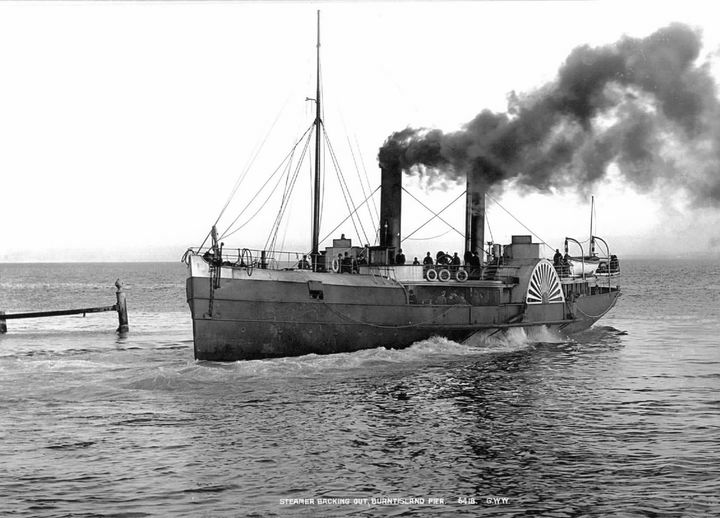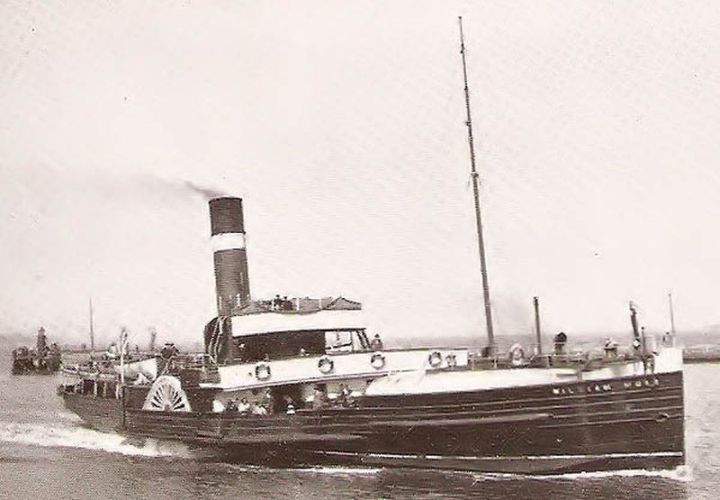paddlesteamers.info : The Internet's leading website for
Side-Wheeled Paddle Steamers
Firth
of Forth,
Scotland
Queensferry Passage : operated until the opening of the Forth Road Bridge in 1964
Queensferry Trustees : Edinburgh & Glasgow Railway from 1863, North British Railway from 1865
Queen Margaret (1821-1841)
William Adam (1838-1866)
Private owner : Wilson family
Forfarshire (1893-1920)
built by Gourlay Bros at Dundee
- for the Scottish Central Railway - 120.5 x 20.1 feet
Single diagonal engine 22 x 36 in
This was a smaller
ship and was sometimes chartered for upriver
excursions
Became part of the Caledonian Railway in 1865
Owned by the Trustees of the Harbour of Dundee from 1873 to 1893
Sold 1893 for service
at Queensferry by JS Wilson and later D Wilson & Son
Reboilered 1904 receiving
a very tall funnel She was disposed of in 1920
London & NorthEastern Railway from 1923
Dundee
(1917-1952)
Built in 1875 by Wm Simons & Co of Renfrew
149.3 ft : 264 GRT
Engine : Compound diagonal 23 and 42 in x 42 in
Built for the Trustees of the Port of Dundee
From 1920-1923 sailed for the Tay Steamboat Company on excursions
On station for the London & North Eastern Railway from 1923
Held in reserve after 1934
William
Denny &
Bros : Diesel Ferries
The lessee
of the
Queensferry Passage from 1934 until the opening of the Forth Road
Bridge 30 years later, the well-known Dumbarton
shipbuilders operated four diesel paddle car ferries. The vessels
were double-ended but side-loaders.
The
1934 pair had Davy-Paxman oil engines with electric transmission. Mary
Queen of Scots and Sir William Wallace were fitted with Crossley
diesels with hydraulic transmission.
Robert the Bruce has the
distinction of being the first ship built in Scotland with an
all-welded hull. Sister ship Queen Margaret was of more traditional
riveted construction.
All except Sir William Wallace were scrapped locally shortly after withdrawal. The latter was scrapped in Belgium in 1970
Queen Margaret (1934-1964) Diesel-electric
Robert the Bruce (1934-1964) Diesel-electric
Mary Queen of Scots (1949-1964) Diesel-hydraulic
Sir William Wallace (1956-1964) Diesel-hydraulic
External website : https://queensferrypassage.co.uk/
Granton to Burntisland : operated until the opening of the Forth (rail) Bridge in 1890
Note: William Muir continued as the sole railway owned passenger paddle steamer after this date
Railway Ownership from 1847
Fife Ferry Trustees
Maid of Leven (1844-1853)
Granton (1844-1856)
Burntisland (1844-1851)
Railway Ferry paddle steamers
From 1847 : Edinburgh & Northern
Railway Co
Leviathan (1849-1890) * World's first purpose-designed railway carriage ferry
Built by Robert Napier of Govan
157.6 ft : 417 GRT (later 167 ft : 399 GRT)
Engine : Twin 1 cylinder
Laid
up in 1890 on completion of the Forth Bridge. Registered to London
owners for a potential sale to Mexico and from 1892 with Thomas Craigie
Glover at Leith but scrapped
Carrier (1858-1882)
Built by Scott & Co of Greenock
124.4 ft : 243 GRT
Engine : Oscillating 42 and 42 x 37 in
At the Isle of Wight from 1884 to 1885 for the Isle of Wight Marine Transit Co
From 1886 with the London, Brighton & South Coast Railway
Scrapped in Sweden in 1893
From 1849 : Edinburgh, Perth
& Dundee Railway Co
Balbirnie (1861-1891)
Built by S&H Morton of Leith
199.6 ft : 533 GRT
Engine : 4 cylinder 43 x 42 in
From 1862 : North British Railway
Kinloch (1865-1890)
Built by A&J Inglis at Glasgow
Length 216 ft : 585 GRT
Engines : Twin diagonal 42 and 42 in x 48 in
Laid up in 1890 on completion of the Forth Bridge. Registered to
London owners for a potential sale to Mexico and from 1892 with Thomas
Craigie Glover at Leith
Scrapped in 1892 at Bo'ness
Midlothian (1881-1890)
Built by Ramage & Ferguson at Leith
Length 262.6 ft : 920 GRT
Engines : Compound diagonal 4 cyl. 2 x 35 and 70 in x 60 in
Passenger Steamers
Maid of Leven
Granton
Burntisland
Forth (1846-1876)
Built by Hawarden Iron Company of Hawarden
144.4 ft : 209 GRT : Engine Oscillating 44 and 44 x 39 in
Auld Reekie (1847-1890)
Built by Miller, Ravenhill & Co of Blackwall, London
141.5 ft : 163 GRT : Engine Oscillating 34 and 34 x 33 in
In 1890 served on the Tayport - Broughty Ferry run after the collapse of the Tay Bridge
Scrapped in 1892 at Bergen, Norway
Thane of Fife (1847-1891)
Built by Miller, Ravenhill & Co of Blackwall, London
141 ft : 171 GRT : Engine Oscillating 34 and 34 x 33 in
Moved to Bergen, Norway as Torsten
Sank at Bergen in 1893
Express (1843-1878)
Built by Miller, Ravenhill & Co of Blackwall, London
153 ft : 269 GRT : Engine Oscillating
Originally on Tay crossing (Tayport-Broughty Ferry)
John Stirling (1876-1892)
Built in 1876 by J Key at Kinghorn
Length 190.3 ft : 427 GRT
Engines : Oscillating.
Disposed of in 1892 to Thomas Craigie Glover, partner in
the S&H Morton shipyard in Leith and a former senior
industrialist in India
Spent time in 1894 on the Manchester Ship Canal on charter
Broken up in Dordrecht, Netherlands in 1899

Above : John Stirling in a widely-published photo by George Washington Wilson
William Muir (1879-1937)
Built in 1879 by J Key at Kinghorn
Length 174.1 ft : 364 GRT
Engines
: Oscillating. Re-engined in 1910 to compound
diagonal 28 and 52 in x 60 in by Ramage & Ferguson of Leith
Twin-funnel, but single-funneled after re-engining
Served as a minesweeper in World War I

Above : William Muir in her later configration
Return
to:
British Paddle Steamer Index
Historical Database

